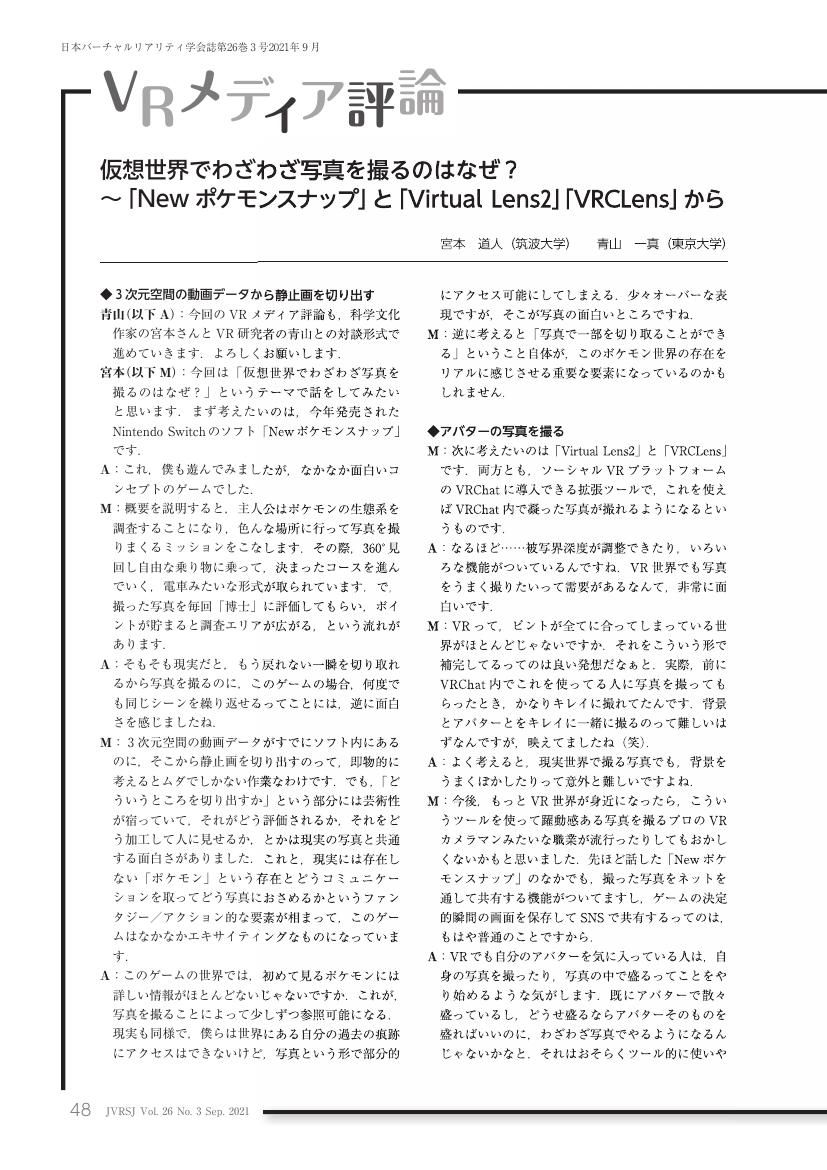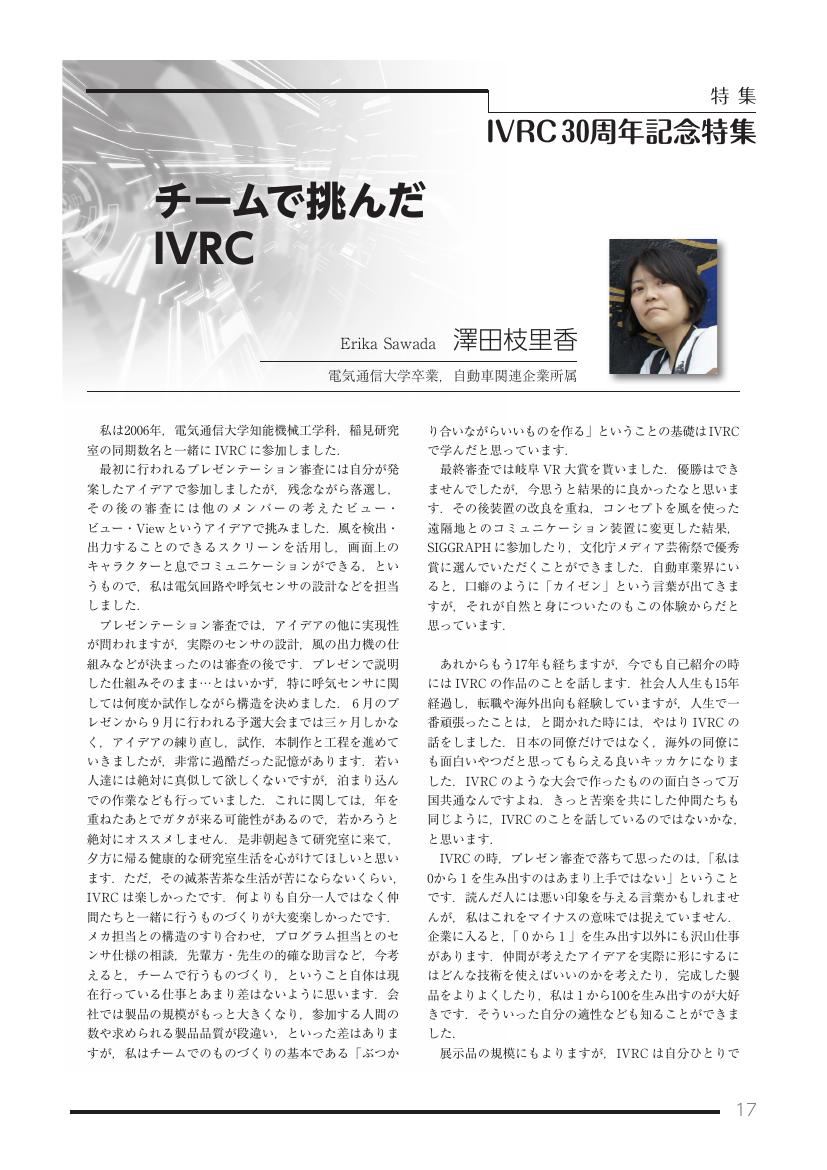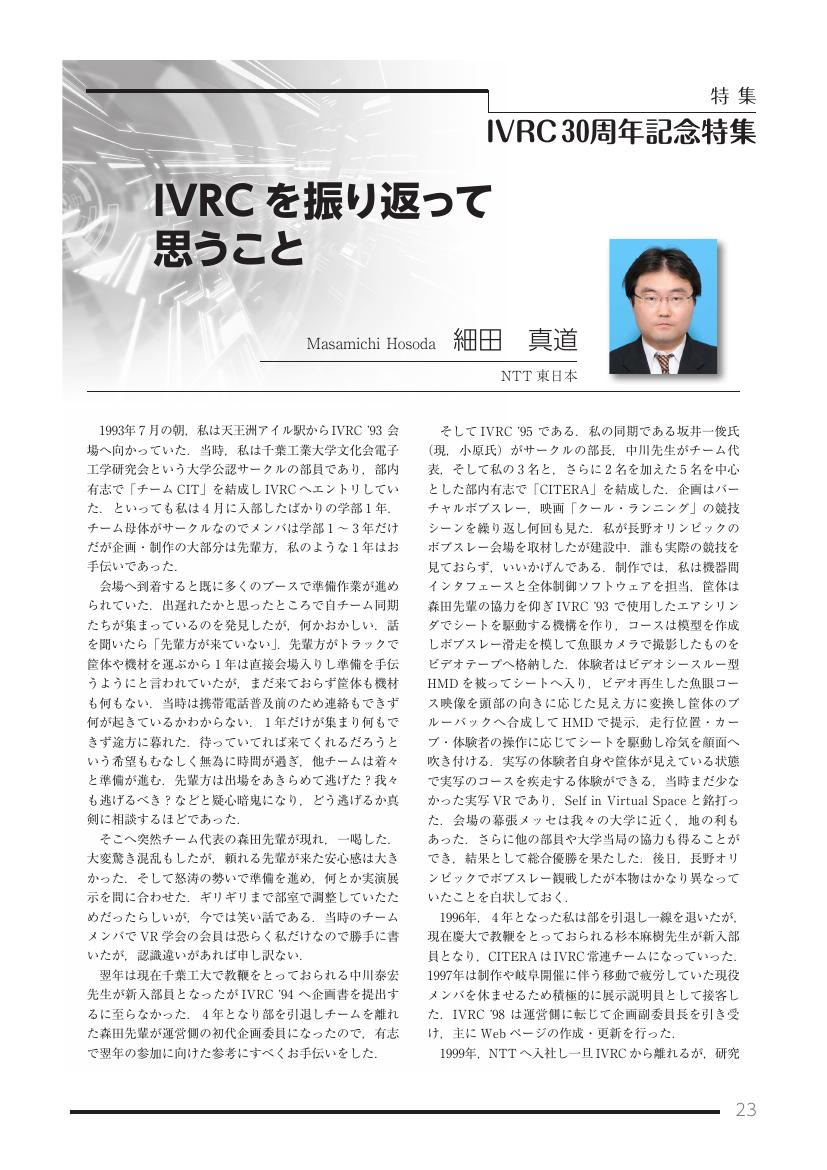6 0 0 0 生得的でない身体部位追加のための身体像の伸展
- 著者
- 松井 和輝 古川 正統 安藤 英由樹 前田 太郎
- 出版者
- 特定非営利活動法人 日本バーチャルリアリティ学会
- 雑誌
- 日本バーチャルリアリティ学会論文誌 (ISSN:1344011X)
- 巻号頁・発行日
- vol.20, no.3, pp.243-252, 2015
We manipulate equipment naturally as an extension of physical ability. However, it is unclear whether we can transform supernumerary body parts to our body image to use the equipment as a similar body parts. So, this study suggests that ownership is formed by the simultaneity of visual and tactile stimulation, and that this perception of ownership is important to form the body image. In addition, we propose that if the equipment appears to be extended continuously from our body and ownership of the equipment occurs, then the body image will be transformed to include the equipment. Therefore, in this study, the equipment was arranged to appear as extending from the body, and visual and tactile stimulation were used to elicit ownership of the equipment. The results confirmed that body image was transformed to include the equipment. Furthermore, this suggested that it is possible to incorporate equipment into one's body image, and that we could use the equipment as a supernumerary our own body-part.
- 著者
- 高下 修聡 荒井 謙 齊藤 寛人 稲見 昌彦
- 出版者
- 特定非営利活動法人 日本バーチャルリアリティ学会
- 雑誌
- 日本バーチャルリアリティ学会論文誌 (ISSN:1344011X)
- 巻号頁・発行日
- vol.27, no.4, pp.403-412, 2022-12-28 (Released:2022-12-28)
- 参考文献数
- 15
Many previous studies have reported on the transformation of perception/behavior, body image, and body schema due to the use of avatars in VR space. However, there are few previous studies on those transformations associated with the wearing of avatars with non-innate physical characteristics such as animal avatars, leaving many unexplored areas. In this study, we focused on the octopus as an example of an animal with non-native physical characteristics such as softness and structural consistency from arm to fingertip. Therefore, we developed an avatar that externally mimics the arm of an octopus, a box-shaped avatar, and a human arm-shaped avatar, and measured the movement of the right upper limb during manipulation and the sensory and cognitive changes after manipulation. The results showed that subjects felt their bodies became softer and their body image changed after manipulating the avatar that imitated an octopus arm. The possibility of behavioral change was also confirmed with the octopus avater.
5 0 0 0 OA 伸長する腕に対する身体性の獲得:伸長実装法による違い
- 著者
- 中川 航太朗 井上 康之 Harin Hapuarachchi 杉本 麻樹 稲見 昌彦 北崎 充晃
- 出版者
- 特定非営利活動法人 日本バーチャルリアリティ学会
- 雑誌
- 日本バーチャルリアリティ学会論文誌 (ISSN:1344011X)
- 巻号頁・発行日
- vol.27, no.4, pp.341-351, 2022-12-28 (Released:2022-12-28)
- 参考文献数
- 45
We aimed to investigate whether illusory embodiment occurs in arms that stretch farther than usual arms in a virtual environment and how embodiment is acquired in different stretching methods. We realized three types of arm stretching methods: the hand extended ten times the actual movement (constant stretching), the hand extended in an accelerated manner (accelerated stretching), and the hand immediately extended to the target when the user fixed the eyes on the target and moved the hand towards the target (instant stretching). Then, we investigated sense of body ownership, sense of agency and task performance for those. We found that the illusory body ownership and sense of agency were higher in the order of constant stretching, accelerated stretching, and instant stretching. The learning effects on embodiment depended on the stretching method. Task performance was better in the order of constant, instant, and accelerated stretching. These results suggest that the illusory embodiment of the stretching arm and its learning depend on the type of stretching.
5 0 0 0 OA 自己アバタの三人称視点操作を用いたself-distancing
- 著者
- 畑田 裕二 吉田 成朗 鳴海 拓志 葛岡 英明
- 出版者
- 特定非営利活動法人 日本バーチャルリアリティ学会
- 雑誌
- 日本バーチャルリアリティ学会論文誌 (ISSN:1344011X)
- 巻号頁・発行日
- vol.26, no.3, pp.198-207, 2021-09-30 (Released:2021-09-30)
- 参考文献数
- 39
Self-distancing is the method of adjusting the psychological distance from one’s own experience. Keeping a psychological distance from the issue affects how we address it. For example, people often devise more creative ideas for others’ problems than for their own problems. In this study, we employed virtual reality for supporting self-distancing. We developed a system that enables the user to operate his/her avatar from the third-person perspective by changing the user’s perspective out of the body. We conducted an experiment in which participants were asked to solve problems that require insight and creative thinking from either the first-person or third-person perspective (3PP). The results indicate that the 3PP increases users’ psychological distance from their experiences and brings greater insight. However, there was no significant difference in the number of ideas that users could devise. Based on these findings, we discuss the interface design required for incorporating self-distancing, regardless of users’ abilities and circumstances.
- 著者
- 谷口 大 小川 浩平 磯邊 友美 後藤 典生 石黒 浩
- 出版者
- 特定非営利活動法人 日本バーチャルリアリティ学会
- 雑誌
- 日本バーチャルリアリティ学会論文誌 (ISSN:1344011X)
- 巻号頁・発行日
- vol.26, no.4, pp.288-297, 2021-12-24 (Released:2021-12-24)
- 参考文献数
- 29
With the development of engineering technology, many attempts have been made to persuade humans using engineering technology. Research on persuasion toward physical purposes using engineering technology has been conducted. For example, about changing attitudes toward purchasing products. On the other hand, for persuasion toward metaphysical purposes such as understanding abstract concepts and religious ideas, no methodology for using engineering technology has been established. This research aimed to realize persuasion toward metaphysical purposes. We focused on persuasion on the peripheral route in the elaboration likelihood model, and targeted transmission of Buddhist Doctrine as a metaphysical content. In order to achieve this, we have developed the media integrating an android and projection mapping. We discussed the relationship between the conventional media for transmission of Buddhist Doctrine and the developed system, and conducted the field experiment to verify the effectiveness of the developed system. As a result of the analysis, it was shown that the developed system could be effective for the transmission of Buddhist Doctrine. In the future, we plan to verify the effectiveness of the developed system outside of the transmission of Buddhism, and the synergistic effects that occur only by integrating an android and projection mapping in laboratory experiments.
- 著者
- 宮本 道人 青山 一真
- 出版者
- 特定非営利活動法人 日本バーチャルリアリティ学会
- 雑誌
- 日本バーチャルリアリティ学会誌 (ISSN:13426680)
- 巻号頁・発行日
- vol.26, no.3, pp.48-49, 2021-09-30 (Released:2021-11-05)
5 0 0 0 OA 回転の皮膚せん断変形に基づく分布型触覚ディスプレイの設計
- 著者
- 堀江 新 下林 秀輝 齊藤 寛人 稲見 昌彦
- 出版者
- 特定非営利活動法人 日本バーチャルリアリティ学会
- 雑誌
- 日本バーチャルリアリティ学会論文誌 (ISSN:1344011X)
- 巻号頁・発行日
- vol.25, no.4, pp.402-411, 2020-12-25 (Released:2020-12-25)
- 参考文献数
- 43
In this paper, we propose a tactile display with multiple stimulus elements that present rotational shear deformation on the skin, and describe the design of a device that applies the proposed method to the back. Shear deformation stimulation to the skin can be used to perceive force in a small device, and numerous methods have been proposed. Among them, methods that present the distribution of spatial shear stimuli are expected to be a method to reproduce skin sensations with high reality. In this study, we propose a tactile display with multiple stimulus elements that present rotational shear deformation to the skin using a rotating motor. A rotary motor is a widely used actuator that is easy to control, and can be scaled to apply to various body parts. In this paper, we design a device that can present the distribution of shear deformation stimuli in the back as an example of the application of this method. In particular, we focused on the size of the rotating tactors and the distance between the tactors among the form factors, and conducted a perception experiment. It was found that when the size of the tactor was 20mm, the direction of rotation was not perceived and the dynamic range of the intensity of the stimulus was maximized, and spatially continuous stimuli could be presented to the back if the distance between the tactors was 60mm or less.
5 0 0 0 OA CHI 2021のGeneral Chairを引き受けることになった経緯
- 著者
- 北村 喜文
- 出版者
- 特定非営利活動法人 日本バーチャルリアリティ学会
- 雑誌
- 日本バーチャルリアリティ学会誌 (ISSN:13426680)
- 巻号頁・発行日
- vol.26, no.1, pp.10-14, 2021-03-31 (Released:2021-05-01)
- 参考文献数
- 20
5 0 0 0 OA IVRC2019(第27回 国際学生対抗バーチャルリアリティコンテスト)開催報告
- 著者
- 舘 暲 岩田 洋夫 安藤 英由樹 小泉 直也 中村 拓人 吉元 俊輔 白井 暁彦 長谷川 晶一
- 出版者
- 特定非営利活動法人 日本バーチャルリアリティ学会
- 雑誌
- 日本バーチャルリアリティ学会誌 (ISSN:13426680)
- 巻号頁・発行日
- vol.24, no.4, pp.39-43, 2019-12-31 (Released:2021-04-08)
5 0 0 0 OA Redirected Jumping:VRにおける跳躍動作時の移動量操作手法
- 著者
- 林 大悟 藤田 和之 高嶋 和毅 Robert W. Lindeman 北村 喜文
- 出版者
- 特定非営利活動法人 日本バーチャルリアリティ学会
- 雑誌
- 日本バーチャルリアリティ学会論文誌 (ISSN:1344011X)
- 巻号頁・発行日
- vol.24, no.4, pp.341-350, 2019 (Released:2019-12-31)
- 参考文献数
- 25
We explore Redirected Jumping, a novel redirection technique which enables us to purposefully manipulate the mapping of the user’s physical jumping movements (e.g. distance and direction) to movements in the virtual space, allowing richer and more active physical VR experiences within a limited tracking area. To demonstrate the possibilities provided by Redirected Jumping, we implemented jumping redirection methods for three basic jumping actions (i.e., horizontal, vertical, and rotational jumps) using common VR devices. We conducted three user studies to investigate the effective manipulation ranges, and the results revealed that our methods can manipulate a user’s jumping movements without them noticing, similar to redirected walking.
5 0 0 0 OA 映像と連携する移動ロボットの投影型制御
- 著者
- 平木 剛史 川原 圭博 苗村 健
- 出版者
- 特定非営利活動法人 日本バーチャルリアリティ学会
- 雑誌
- 日本バーチャルリアリティ学会論文誌 (ISSN:1344011X)
- 巻号頁・発行日
- vol.25, no.2, pp.148-157, 2020 (Released:2020-06-30)
- 参考文献数
- 57
Collaborative control system between digital images and multiple robots has attracted increasing attention in the robot environment for displaying information to users. We surveyed the projection-based robot control method for enabling this control system and its applications in the fields of mixed reality and user interfaces. In this paper, we described the requirements of the robot environment for displaying information to users, the related studies of the projection-based robot control system as user interfaces, and the robot control methods using velocity vector fields that was applied in the projection-based robot control. In addition, we described the characteristics and applications of the projection-based robot control system using pixel-level visible light communication.
- 著者
- 渡邉 英徳
- 出版者
- 特定非営利活動法人 日本バーチャルリアリティ学会
- 雑誌
- 日本バーチャルリアリティ学会論文誌 (ISSN:1344011X)
- 巻号頁・発行日
- vol.14, no.2, pp.157-162, 2009
- 参考文献数
- 15
We propose a new design methodology for 3Di (3D Internet). The designer should pay attention to 1. the visibility, 2. direct accessibility, and 3. spatialization of the target object. We have applied this methodology for producing and designing plenty of architectural and artistic space in 3Di. This paper explains the concept and concrete design methodology thorough applied artworks.
5 0 0 0 OA 「クロスモーダル/マルチモーダル2」特集号刊行にあたって
- 著者
- 鳴海 拓志 小泉 直也 北川 智利
- 出版者
- 特定非営利活動法人 日本バーチャルリアリティ学会
- 雑誌
- 日本バーチャルリアリティ学会論文誌 (ISSN:1344011X)
- 巻号頁・発行日
- vol.23, no.3, pp.79, 2018 (Released:2018-09-30)
4 0 0 0 OA モーションラインによる運動の滑らかさの向上
- 著者
- 東 知宏 伊藤 裕之 須長 正治 妹尾 武治
- 出版者
- 特定非営利活動法人 日本バーチャルリアリティ学会
- 雑誌
- 日本バーチャルリアリティ学会論文誌 (ISSN:1344011X)
- 巻号頁・発行日
- vol.21, no.3, pp.521-524, 2016 (Released:2016-10-31)
- 参考文献数
- 7
Motion lines have been studied as expression of motion in static images. We investigated an effect of motion lines in apparent-motion displays. The smoothness of two-frame apparent motion was enhanced by presentation of a motion line between the frames, and even by simultaneous presentation of a motion line attached to an object in the first or the last frame. We additionally proved that the effect of motion lines becomes highlighted with an extended distance between apparent-motion components. The use of motion lines may contribute to production of various types of movies from the point of smoother motion impression with reduced computational load.
4 0 0 0 OA VR研究者がChatGPTに聞いてみた
- 著者
- 森 尚平 片岡 佑太 斎藤 英雄 ステファニ・ツォルマン ペーター・モア クリストフ・エブナー
- 出版者
- 特定非営利活動法人 日本バーチャルリアリティ学会
- 雑誌
- 日本バーチャルリアリティ学会誌 (ISSN:13426680)
- 巻号頁・発行日
- vol.28, no.2, pp.56-65, 2023-06-30 (Released:2023-07-27)
4 0 0 0 OA ハプソニック・アート:触感を伝えるサウンド・アート
- 著者
- 中島 武三志
- 出版者
- 特定非営利活動法人 日本バーチャルリアリティ学会
- 雑誌
- 日本バーチャルリアリティ学会論文誌 (ISSN:1344011X)
- 巻号頁・発行日
- vol.28, no.2, pp.71-79, 2023 (Released:2023-06-30)
- 参考文献数
- 45
In sound art, an art style that uses sound, the device that generates sound is the core of the work and one of the elements in which the artist’s originality is most pronounced. There is also sound art in which sound is generated and received by touching the work itself. This paper calls sound art, in which tactile sensation is one of the elements of the work experience, “Hapsonic art” and pursues its possibilities as an art style. First, this paper discusses the characteristics of hapsonic art from the perspectives of somatosensory aspects, properties of tactile objects, and activeness of appreciation. Next, while citing other art styles related to hapsonic art, such as musical instruments/musical tools, art for disabilities, kinetic art, and interactive art, this paper organizes similarities and differences from hapsonic art. In addition, while citing other academic research areas related to hapsonic art, this paper makes a proposal for the future development of hapsonic art from the perspectives of somatosensory aspects, materiality, kinetic nature, and activeness/interaction as the characteristics of hapsonic art.
4 0 0 0 OA チームで挑んだIVRC
- 著者
- 澤田 枝里香
- 出版者
- 特定非営利活動法人 日本バーチャルリアリティ学会
- 雑誌
- 日本バーチャルリアリティ学会誌 (ISSN:13426680)
- 巻号頁・発行日
- vol.28, no.1, pp.17-18, 2023-03-31 (Released:2023-04-26)
4 0 0 0 OA IVRCを振り返って思うこと
- 著者
- 鈴木 謙太
- 出版者
- 特定非営利活動法人 日本バーチャルリアリティ学会
- 雑誌
- 日本バーチャルリアリティ学会誌 (ISSN:13426680)
- 巻号頁・発行日
- vol.28, no.1, pp.19-20, 2023-03-31 (Released:2023-04-26)
4 0 0 0 OA IVRCを振り返って思うこと
- 著者
- 細田 真道
- 出版者
- 特定非営利活動法人 日本バーチャルリアリティ学会
- 雑誌
- 日本バーチャルリアリティ学会誌 (ISSN:13426680)
- 巻号頁・発行日
- vol.28, no.1, pp.23-24, 2023-03-31 (Released:2023-04-26)
4 0 0 0 OA ホールド難度と配置を考慮したボルダリング課題の自動難度推定
- 著者
- 大西 和歩 浦西 友樹 劉 暢 Photchara Ratsamee 東田 学 山本 豪志朗 竹村 治雄
- 出版者
- 特定非営利活動法人 日本バーチャルリアリティ学会
- 雑誌
- 日本バーチャルリアリティ学会論文誌 (ISSN:1344011X)
- 巻号頁・発行日
- vol.27, no.4, pp.331-340, 2022-12-28 (Released:2022-12-28)
- 参考文献数
- 16
Bouldering is a sport where competitors climb an artificial wall using holds as support. The climbing route from start to end is called a problem and each problem has its difficulty grade. As the grade of a problem plays an essential role in measuring climber’s ability, a unified standard is desirable. However, measuring the grade still currently relies on personal experience of the routesetters, which results in huge individual difference. The purpose of this study is to evaluate the grade of a bouldering problem in a uniformed manner. Specifically, we propose a two-step machine learning model that takes into account the difficulty and arrangement of each single hold. Experimental results using 11906 problems show that our model has achieved up to 65.5% of accuracy for classifying 13 classes of problem grades.




